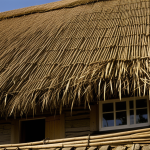Essential Principles of Thatch Preservation in Rural England
Understanding thatched roof preservation in rural England begins with acknowledging its crucial role in protecting cultural heritage. These roofs are more than aesthetics; they support structural integrity and contribute to energy efficiency by providing natural insulation. Preservation involves balancing traditional craftsmanship with modern conservation advice to extend roof lifespan.
Traditional versus modern heritage roofing philosophies differ mainly in material sourcing and methods used. Traditional approaches emphasize local materials like longstraw or water reed, maintained through hand craftsmanship passed down generations. Modern philosophies often integrate synthetic fire retardants or advanced weatherproofing techniques, meeting today’s safety and durability standards while respecting original structures.
In the same genre : Transforming cardiff: the impact of new urban projects on real estate dynamics
Proactive and routine maintenance principles are essential for effective preservation. Regular inspections help identify early signs of wear caused by weather exposure or animal activity. This vigilance prevents minor issues from escalating and preserves the delicate balance between authenticity and functionality. Embracing these essential principles ensures that thatched roofs continue to enhance rural English landscapes for decades to come.
Essential Principles of Thatch Preservation in Rural England
Thatch preservation in rural England hinges on understanding its vital role in heritage roofing. These roofs are more than aesthetic—preserving them sustains cultural heritage, maintains structural integrity, and supports natural energy efficiency. Awareness of these core reasons informs effective maintenance principles.
Traditional preservation typically involves hands-on, natural remedies that respect age-old craftsmanship. Modern philosophies may integrate synthetic fire retardants or protective coatings but risk compromising the roof’s breathability and authenticity. Balancing tradition and innovation is key.
Proactive care is indispensable. Routine inspections reveal early signs of decay or damage, preventing costly repairs. Regular removal of debris and moss preserves thatch longevity. Ignoring small problems can accelerate deterioration, undermining both looks and function.
Overall, conservation advice for thatched roof preservation in rural England stresses a mindful approach. Understanding the importance of heritage roofing encourages property owners to invest in continuous, preventive care—ensuring these iconic roofs endure for generations to come.
Expert Maintenance Techniques for Thatched Roofs
Maintaining a thatched roof requires expert advice and meticulous attention to detail. Annual inspections are crucial: begin by checking ridge wear, loose or missing spars, and signs of water ingress. Expert thatchers recommend removing debris early—fallen leaves and twigs can trap moisture, accelerating deterioration. Moss control is equally important; while some moss adds charm, excessive growth invites rot. Gently brushing moss off with a soft, non-abrasive tool preserves the thatch’s integrity without damage.
Preventative care is foundational to thatched roof maintenance. Regularly clearing gutters and ensuring proper drainage prevents water pooling, which undermines roof longevity. When hiring professional thatchers, credentials matter. Look for those affiliated with reputable bodies like the National Federation of Roofing Contractors. Red flags include vague timelines or reluctance to provide references. Experienced professionals apply rural roofing techniques tailored to the property’s climate and material type, balancing tradition with modern preservation essentials.
Following these expert maintenance steps extends roof life and protects rural heritage, embodying the practical heart of thatched roof preservation.
Expert Maintenance Techniques for Thatched Roofs
Effective thatched roof maintenance demands a clear, expert-driven routine to safeguard these iconic rural roofs. Annual inspections are vital, focusing on areas prone to wear such as ridges and eaves. Early detection of damage allows immediate intervention, reducing costly repairs.
Cleaning plays a crucial role. Regular debris removal prevents moisture retention, which can accelerate decay. Moss control, using gentle brushing techniques rather than harsh chemicals, protects the thatch’s breathability and longevity.
When hiring professional thatchers, credentials matter. Seek those with certification from recognized heritage roofing bodies and experience in rural roofing techniques. Red flags include providers offering overly cheap, rapid fixes or lacking references.
Preventative care also involves minor repairs, such as patching small bare spots to avoid water ingress. Maintaining proper ridge thickness, as recommended by experienced thatchers, enhances durability and fire resistance.
Incorporating these expert recommendations empowers property owners to maintain their thatched roofs effectively, preserving both function and historic character.
Traditional and Regional Thatching Methods
Thatched roof preservation in rural England deeply reflects traditional thatching and regional techniques, each shaped by local materials and climate. Common styles include Longstraw, Combed Wheat Reed, and Water Reed—each offering unique texture and durability. Longstraw, often used in eastern England, features longer straw bundled tightly to shed water effectively. Water Reed, prevalent in wetter western regions, provides a dense, resilient layer that withstands heavy rain.
These heritage methods rely on craftsmanship passed down through generations. Thatched roof preservation benefits from this accumulated knowledge while adapting best practices to evolving weather patterns. Regional climates directly impact preservation: wetter areas demand tighter, thicker thatch layers to resist water ingress; drier zones can focus more on fire safety and pest prevention.
Understanding these nuances is vital. Rural owners who appreciate how regional techniques inform maintenance principles can better select materials and schedules tailored to their setting. Balancing tradition with modern conservation advice ensures that this craft remains both authentic and durable, safeguarding England’s rural architectural identity.
Essential Principles of Thatch Preservation in Rural England
Thatched roof preservation in rural England rests on three core reasons: sustaining cultural heritage, preserving structural integrity, and enhancing natural energy efficiency. These ancient roofs encapsulate local history while offering insulation that modern materials often cannot match. Preservation efforts must respect these foundational values.
Traditional versus modern preservation philosophies differ markedly. Traditional approaches rely on age-old, heritage roofing techniques, using locally sourced materials like longstraw or water reed that complement rural England’s climate. These methods emphasize craftsmanship passed down through generations. Modern philosophies, conversely, integrate synthetic materials and fire retardants to meet contemporary safety norms, though at times risking alteration of the roof’s breathability and authenticity.
The linchpin of successful preservation is adherence to proactive and routine maintenance principles. Regular inspections identify early signs of wear, allowing timely repairs that prevent water ingress and fungal growth. Debris removal and moss control sustain both appearance and function. Following informed conservation advice ensures that the charm and durability of these iconic roofs endure for future generations.
Essential Principles of Thatch Preservation in Rural England
Thatched roof preservation in rural England serves vital roles: it protects cultural heritage, maintains structural integrity, and enhances energy efficiency through natural insulation. These core reasons guide effective maintenance principles, ensuring that heritage roofing remains functional and visually authentic.
Traditional preservation favors natural materials and methods, emphasising hand craftsmanship using local straw or reed. By contrast, modern approaches introduce synthetic fire retardants and weatherproof treatments aimed at durability and safety. Yet, these can challenge the roof’s breathability and historic character, highlighting the need to carefully balance tradition with innovation.
Proactive, routine care is critical. Regular inspections detect wear or damage early—such as loose spars or water ingress—allowing prompt repairs before issues escalate. Consistent debris and moss removal prevent moisture retention, a frequent cause of rot. Following expert conservation advice helps owners maintain authenticity while adapting to evolving environmental conditions, safeguarding these iconic roofs in rural England for the future.
Essential Principles of Thatch Preservation in Rural England
Preserving a thatched roof in rural England hinges on three core reasons: conserving cultural heritage, maintaining structural integrity, and promoting natural energy efficiency. These roofs embody local history and craftsmanship, offering insulation unmatched by many modern materials. Effective thatched roof preservation respects these values through mindful maintenance.
Traditional versus modern heritage roofing philosophies differ distinctly. Traditional methods use locally sourced materials such as longstraw or water reed, highlighting generational handcraftsmanship that suits England’s varied climate. Conversely, modern practices incorporate synthetic fire retardants and weatherproofing treatments. While these improve durability and safety, they may alter the roof’s breathability and authenticity.
Proactive and routine maintenance principles are paramount. Regular inspections detect early signs of wear or water ingress before damage escalates. Timely debris clearance and moss management help preserve the roof’s function and appearance. Applying informed conservation advice ensures that these iconic rural roofs remain both beautiful and resilient, securing their place in England’s architectural heritage.
Essential Principles of Thatch Preservation in Rural England
Thatched roof preservation in rural England contributes significantly to cultural heritage, structural integrity, and natural energy efficiency. Preserving these roofs maintains their historic character while offering insulation benefits that reduce heating costs. Understanding these core reasons clarifies why thatched roof preservation demands careful attention.
Traditional preservation relies heavily on local materials and time-honoured craftsmanship, emphasizing natural straw or reed that suit the English climate. Modern preservation philosophies, on the other hand, introduce synthetic fire retardants and weatherproof treatments to improve durability and safety. However, these modern methods risk altering the roof’s breathability and visual authenticity, so they must be applied judiciously.
Proactive care and routine maintenance principles are vital. Regular inspections detect signs of deterioration such as loose spars or moisture ingress, allowing timely repairs. Consistent removal of debris and moss prevents accumulation of moisture that can cause rot. Following expert conservation advice helps owners balance heritage roofing traditions with necessary modern interventions, securing thatched roofs’ longevity across rural England.
Essential Principles of Thatch Preservation in Rural England
Preserving thatched roofs in rural England safeguards cultural heritage, maintains structural integrity, and ensures energy efficiency. These roofs, made from natural materials, represent centuries of local craftsmanship and provide insulation unmatched by many modern materials. Understanding these core reasons shapes effective maintenance principles.
Traditional preservation centers on using locally sourced straw or reed with manual techniques rooted in heritage roofing. This hands-on approach supports the roof’s breathability and authenticity. In contrast, modern philosophies introduce synthetic fire retardants and weatherproofing to meet safety standards. However, such treatments may affect the roof’s natural properties, requiring careful application.
Proactive care is essential. Routine inspections should focus on early signs of wear, such as loose spars or initial water ingress, that threaten structural integrity. Timely debris removal and moss control reduce moisture retention, a key factor in decay. Following expert conservation advice helps rural homeowners balance tradition and innovation, securing the roof’s longevity while respecting its historic character. This approach ensures that thatched roofs remain a vibrant part of England’s rural landscape.
Essential Principles of Thatch Preservation in Rural England
Thatched roof preservation in rural England is essential for protecting cultural heritage, maintaining structural integrity, and enhancing natural energy efficiency through insulation. These roofs, crafted from local materials like longstraw or water reed, embody traditional heritage roofing methods that are both functional and historically significant.
Traditional preservation philosophies prioritize authentic materials and handcraftsmanship, ensuring the roof’s breathability and harmony with the environment. Modern approaches introduce synthetic fire retardants and weatherproof coatings to meet safety regulations; however, such treatments may impact the roof’s natural properties, risking reduced ventilation and authenticity.
Proactive and routine maintenance principles form the cornerstone of effective preservation. Regular inspections focus on detecting early signs of wear, such as loose spars or water ingress, enabling prompt repairs before issues worsen. Debris clearance and moss control are vital to prevent moisture buildup, which accelerates decay. Adhering to expert conservation advice helps rural homeowners balance respect for tradition with necessary modern interventions, safeguarding these iconic roofs for future generations.











